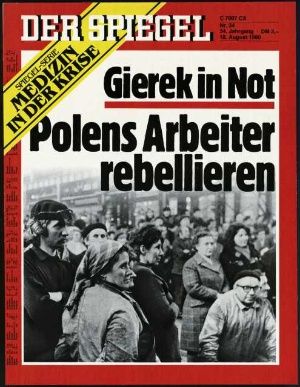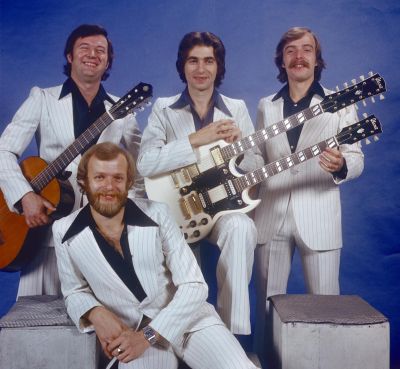Poland’s path to freedom on SPIEGEL covers 1980 to 1990
Mediathek Sorted


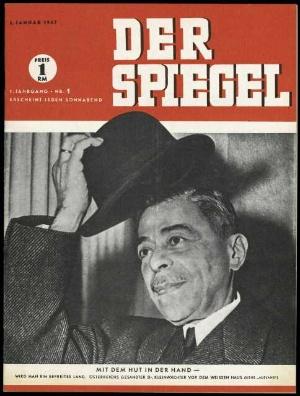

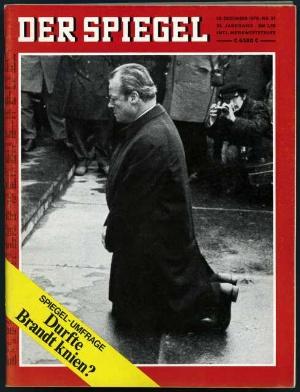
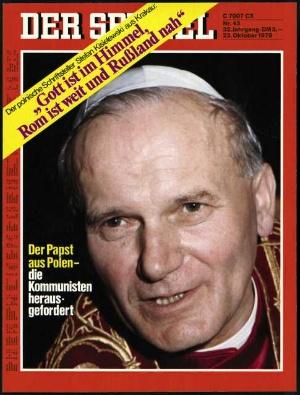
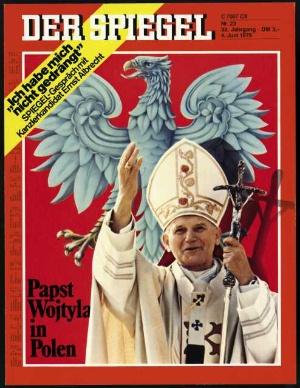
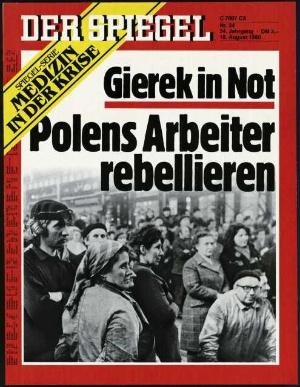
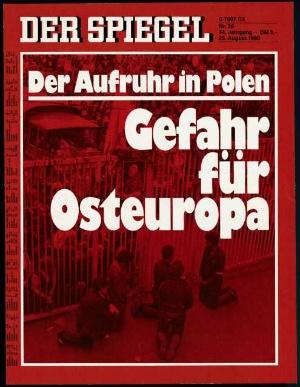
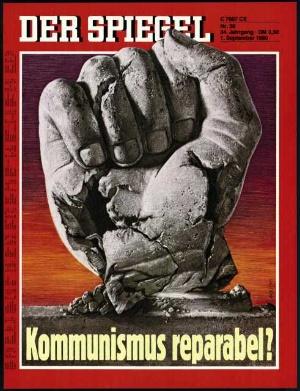

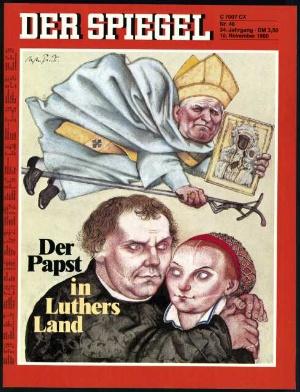

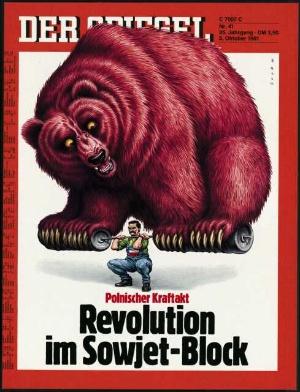

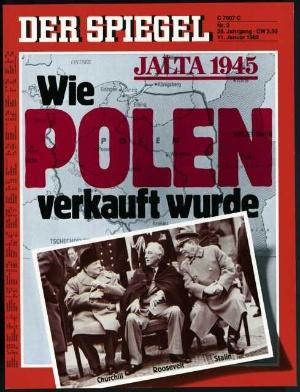
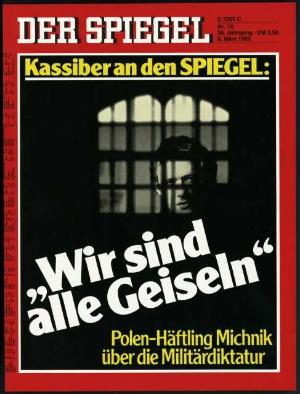
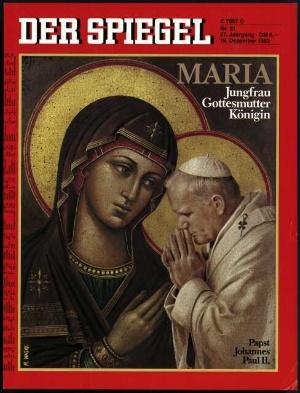

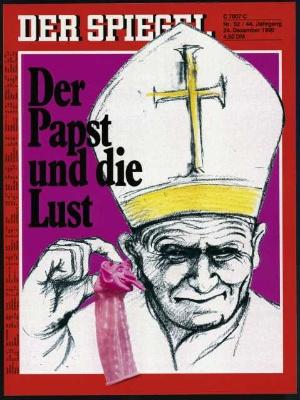

A few weeks before the proclamation of the state of emergency in Poland, also known colloquially as martial law, the Polish issue was back on the cover of the magazine. The October issue 41/1981 appeared with a cover which received a lot of attention at the time because it showed the very curious scene of a crouching Lech Wałęsa as a weight lifter. (Fig. 14) An enormous red bear is sitting on the already heavy weight that the leader of the Polish worker movement has to lift. The symbolism captured by the artist clearly makes one think of the “Russian predator” that the power athlete is wrestling. The weight, the size of the predator and its angry countenance create a threatening atmosphere through the aggression, presumably of the USSR. At the same time, the enormous responsibility resting on his shoulders does not appear to affect Wałęsa. This very popular cover was created by the French graphic artist and cartoonist Jean Sole. The penultimate issue in 1981 was also devoted to Polish subject matters. The cover of issue 52/1981 referred directly to the state of emergency proclaimed on 13 December. (Fig. 15) The photomontage shows General Wojciech Jaruzelski, who was at the head of the State after martial law was introduced. In the background you can see soldiers of the Polish People’s Army (Ludowe Wojsko Polskie). The cover story of this issue is called “Partei am Ende – Militär soll Polen retten” (“Party finished – Military to rescue Poland”). In this context, the cover of issue 2/1982 in the January of that year can be seen as a continuation of the theme. (Fig. 16) It takes up the previously mentioned historical and geopolitical developments in Poland after 1945. The cover story of this issue explained the significance of Poland to the USSR and the system of the Eastern Bloc states to the West German reader. The photo, with a map shown in the background, portrays the protagonists of the conference of the “Big Three”: Winston Churchill, Franklin Delano Roosevelt and Joseph Stalin. On the cover is the headline “Jalta 1945 – Wie Polen verkauft wurde” (“Yalta 1945 – How Poland was sold”). The decisive months for Poland between August 1980 and 13 December 1981, when resistance by the opposition was suppressed by the imposition of martial law, were reflected in the magazine’s almost weekly reporting on the current situation, as well as in the covers of the weekly magazine, which were devoted to Poland and its popular representatives. The final cover during this turbulent period related to the situation with the members of the opposition who had been interned by the military dictatorship. (Fig. 17) A photomontage was chosen for the cover of issue 10/1982 from 8 March on which Adam Michnik, one of the most important members of the opposition, can be seen behind a barred cell window. The cover announces “Kassiber an den Spiegel: ‚Wir sind alle Geiseln‘ – Polen-Häftling Michnik über die Militärdiktatur“ (“Secret message to the Spiegel: ‘We are all hostages’ – Poland prisoner Michnik on the military dictatorship”).
The next three years did not feature any Polish themes on the covers of the magazine. Even when Pope John Paul II was shown on the cover of issue 51/1983, it was without any conscious reference to the social and political situation in Poland. (Fig. 18) As the main story of this issue, the editors dealt with the significance of the adoration of the Virgin Mary in the Catholic Church. On the issue’s cover is Maria, the mother of God to whom John Paul II is praying. Their portrayal is down to the German painter Mathias Waske. The relative stabilisation of the situation in Poland enforced by the military dictatorship was also based on the control of information, only some of which seeping through to Western media was uncensored. Since the official lifting of martial law on 23 July 1983, the Polish authorities were certain in the knowledge that there would be no rapid return to the old dualism, with the party officially representing the interests of society whilst the latter pursued its own grassroots democratic forms of representation of interests. From 1983 to 1987 and 1988, the Hamburg weekly magazine disseminated virtually no communications about Poland or “Polish” covers. During this time, there was only one single cover that addressed a Polish theme by putting the murder of the Solidarność priest Jerzy Popiełuszko from 1984 on the cover. (Fig. 19) Issue 5/1985 of 28 January published a section of a photo of Popiełuszko with the headline “Wie der Geheimdienst mordete – Prozess in Polen” (“How the secret service murdered – Proceedings in Poland”) on the cover, with the word “Prozess” clearly mirroring the font and colour of the word mark Solidarność. The cover story dealt with the proceedings against the Popiełuszko murderers and with the impact of the political murder on the internal affairs of the People’s Republic of Poland.





















































































